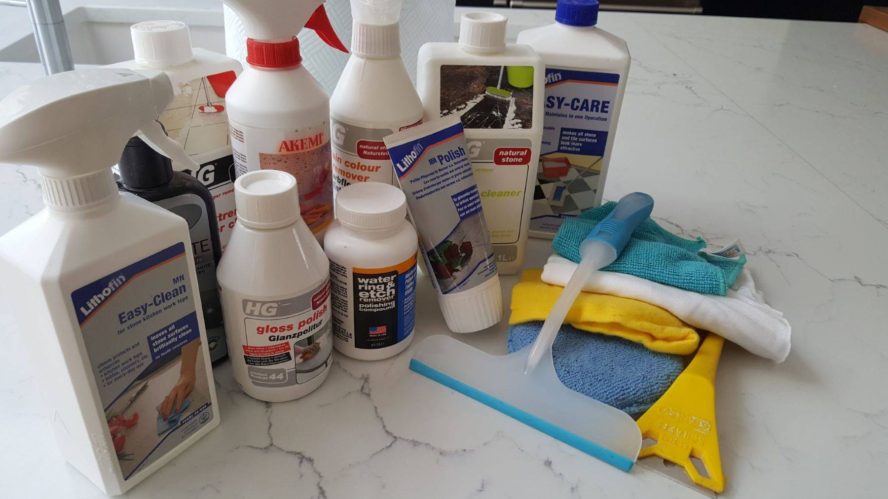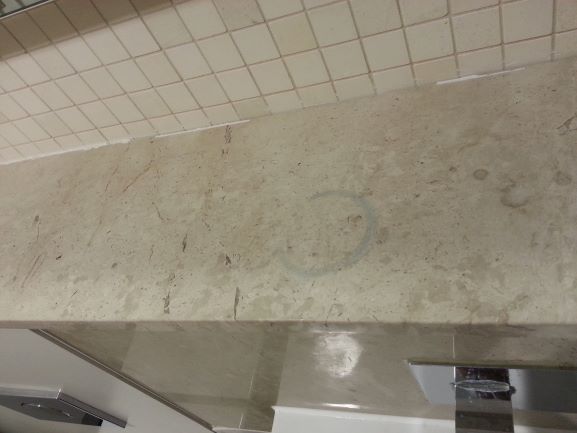This is a general guide on how to care for and clean natural stone. It is for homeowners, tenants and as a help to landlords to advise their tenants. This guide is based on my personal experiences while repairing and restoring natural stone in homes and offices over the last 25 years. Hopefully, it will help all parties avoid costly repairs.
PREVENTION IS BETTER THAN CURE
To start here are some Natural Stone Cleaning Do’s and Don’ts which apply to all areas of your property. Further on I have split this into different areas of the home. J
7 THINGS YOU SHOULD ALWAYS DO
Do dry dust all surfaces frequently and dry mop floors as often as possible. Dusty shelves and window sills etc, dry dust them first before using a detergent to clean them. Sweep surface dust and debris from a stone floor with a soft bristle broom or flat micro fibre mop. Constant use of a stiff bristle broom will scratch polished stone floors.
Do clean surfaces with very mild detergents or stone soap. You should never need to use strong chemicals if you clean all your stone surfaces regularly. A good cleaning agent for stone is HG Neutral Cleaner for Natural Stone.
Do dry surfaces immediately after cleaning. Avoid leaving any substances to dry on the surface of the stone, not even water. Use a separate dry cloth and buff the surface dry.
Do blot spills immediately with a clean cloth or kitchen towels and avoid wiping. For example, wiping wine off a marble table will cause it to affect a larger area. Always blot and you will contain the spillage and damage to one spot.
Do set the vacuum to the hard floor setting. The brushes should be touching the floor and not the metal or plastic part of the floor tool. Incorrect use of the vacuum will scratch a natural stone floor. Removing scratches and re-polishing a natural stone floor is very expensive.
Do use non-slip mats or towels in areas likely to get wet. Remove them when cleaning and allow the floor to dry before replacing them. Stone floors will discolour if any water is constantly trapped between the stone and a matt.
Do ask tradesmen working in your home to use groundsheets and protect all surfaces before starting work. Screws, nails, hammers and pliers etc can do a lot of damage to natural stone.
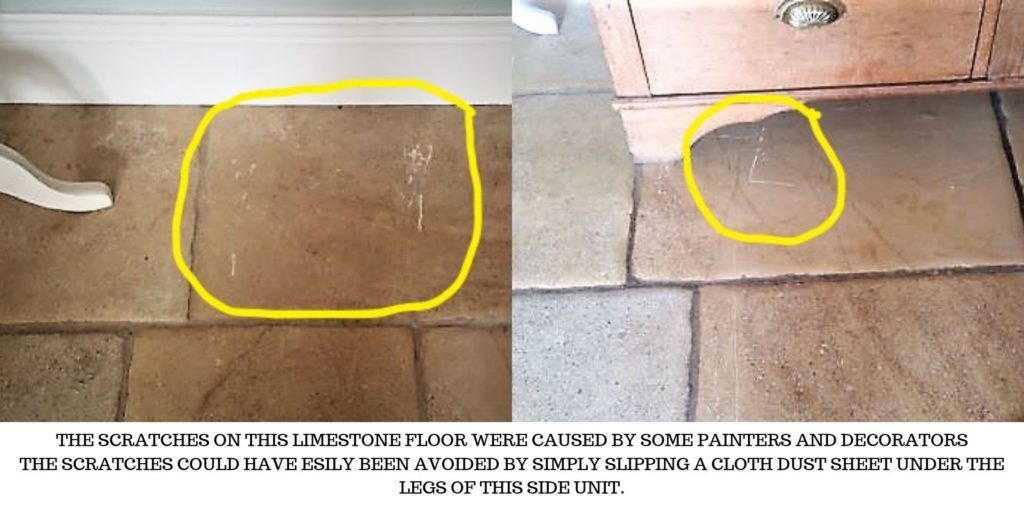
6 THINGS TO AVOID DOING
Don’t use vinegar, lemon juice or any cleaning chemical containing acid to clean marble and limestone, wherever possible use a neutral or mild alkaline chemical. Always read the product labels to be sure that it is suitable for natural stone.
Don’t use green scouring pads, wire wool or any other dry abrasives to clean marble, limestone or any polished stones.

Don’t use cleaning chemicals containing abrasives in them. Wet abrasive and dry powdered cleaners will scratch most natural stones. The use of these types of cleaning agents will strip off a seal and leave a polished surface looking dull.
Don’t assume that because the stone has been sealed it does not need regular cleaning, it does. The seal is to aid daily or regular cleaning, not a substitute for cleaning the stone.
Don’t allow any liquids to dry on the surface of the stone, not even water. Limescale will form on natural stone and it can be difficult to remove. Soapy water, toothpaste and shaving foam will leave dull spots on a marble vanity top. Never leave these substances to dry on a stone surface. The same can be said of aftershave and perfume.
Don’t assume that natural stone cannot be damaged because it is a hard surface. Do not drag or slide objects across the surface, it will scratch. Do not drop heavy objects onto the stone, it will chip or crack.
QUICK LINKS
1. KITCHEN WORKTOPS
2. FLOORS
3. BATHROOMS AND TOILETS
4. DINING TABLES AND COFFEE TABLES
5. FIREPLACE (MANTLE)
6. FIREPLACE HEARTH
SEALED NATURAL STONE
All types of natural stone should be sealed in all areas of your home to protect the stone. Sealing the stone will aid general or daily cleaning. There are two types, Topical Sealers that protect the surface of the stone, Penetrating Sealers sink into the stone. If you have selected a topical seal, your focus is on cleaning and maintain the seal. Penetrating sealers prevent substances from sinking into the stone, cleaning will then be focused on the surface of the stone.
If you clean the stone on a weekly or daily basis before it has been sealed. After it has been sealed you should continue with the same regularity and spillages cleaned up straight away. Sealing the stone is an aid to regular cleaning and maintenance, not a substitute for it.
Kitchen Worktops
Keep it dry – 90% of the problems I encounter with worktops particularly Marble worktops is with liquids. Most people do not wipe down and dry the surface after use or they leave spillages to dry on the stone. Get into the habit of blotting spillages, wiping the surface down with a damp cloth and before it dries buff it dry with a separate cloth.
Check under your soap dispensers and bottles of cleaning fluids regularly and keep them dry. Cleaning chemicals will discolour most natural stone if left for long periods of time.
Report or fix leaks as soon as possible – Limescale does form very easily on natural stone. Extra care should be taken with marble worktops, the limescale will eventually eat away at the stone. Something as simple as changing a washer will save you a lot of money.
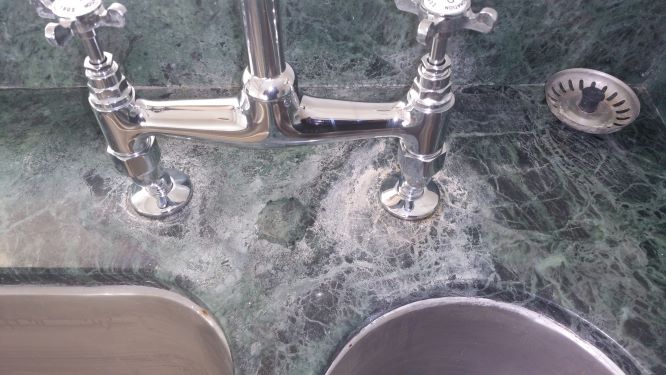
Use a chopping board – Even surfaces as hard as Granite will scratch if you use enough force. Marble scratches very easily. C
Weak areas of the worktop
Avoid putting any weight on the areas in front of the sink and the cooker hob. They are the weakest points of the worktop.
These are areas which can be difficult to repair as they require some support underneath. Repairs of this nature are expensive if the section has to be replaced the costs are even higher.

Chipped edges and corners – The edges of stone worktops will chip if you hit them hard enough. Be careful when lifting pots and pans in and out of the sink and when loading and unloading the dishwasher. In most cases when I repair a small chip, I find most people are unaware that materials like granite can be damaged.
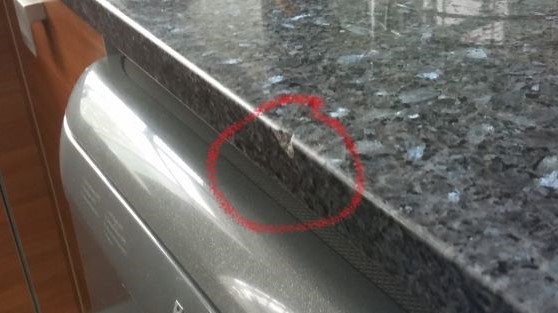
Floors (All areas)
Adjust the floor tool on your vacuum to the hard floor setting. The plastic or metal strip under the floor tool will scratch most Natural Stone Floors

THE METAL PART OF THE FLOOR TOOL WILL SCRATCH THE FLOOR.
Vacuum or sweep the floors regularly bits of dirt or grit on a polished floor will eventually lead to scratches. A lot of dust on a polished floor can be slippery and could cause accidents.
Moveable furniture – Chairs moving back and forth over a polished floor will cause a lot of damage. To avoid this stick some cork, felt or rubber pads under the chair legs. Other items of furniture that are moved around should be lifted and placed in a new position. Avoid dragging or sliding furniture over a stone floor
CLEANING A NATURAL STONE FLOOR
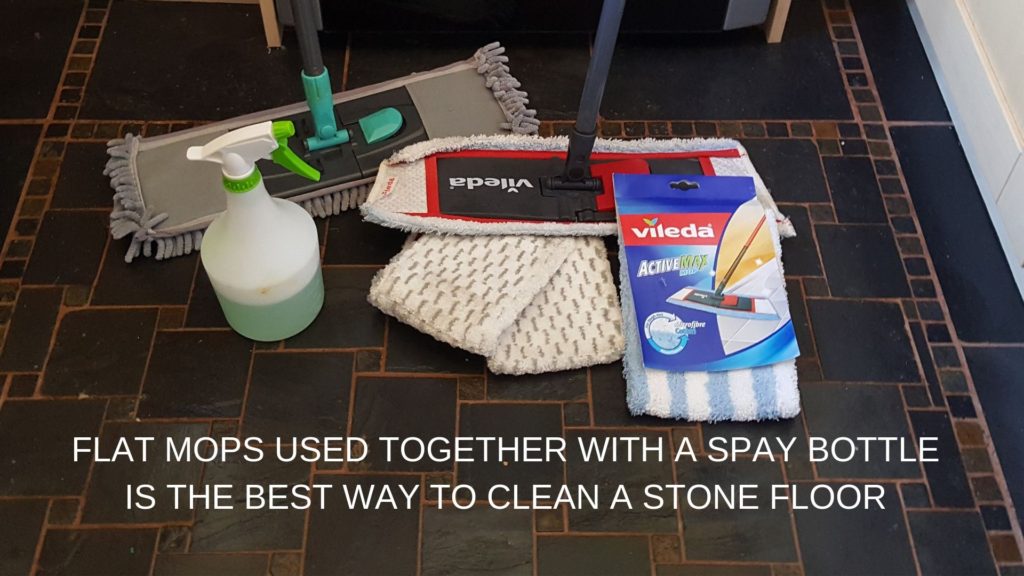
Ditch the old-style mop and bucket and use a flat mop and spray bottle for cleaning the floors. Buy as many spare flat mop heads as you can. When cleaning an area like the kitchen floor prepare a solution of water and detergent in your spray bottle and mist spray a small area and mop it until it is as dry as possible. You should use 2 or 3 mop heads in the kitchen. Use one in front of the cooker, another in front of the sink and a final change of mop head to do the remaining areas. You will be surprised how little time this takes, and the floor will be much cleaner.
Change to a clean mop head for every floor area of your property, when you have cleaned all areas of your home wash and dry all the mops that you used. That way you will have clean materials to use the next time you clean your home, instead of using the same old dirty mop and bucket repeatedly.
RUBBISH BAGS AND BINS
Avoid using rubbish bins with a metal base. Moisture under the bin or a leaking rubbish bag in the bin will cause the metal to react with the stone. On a marble or limestone floor, it will leave a rust mark.

LEAKING BINS, RUBBISH BAGS & A METAL BASED BIN
Never leave rubbish bags with part empty bottles of oil or alcohol etc in them on a stone floor. If the bag leaks these substances will mark the floor. If left overnight this will result in very expensive repairs or the affected floor tiles may have to be replaced. Oil stains on a limestone floor may take several applications of a poultice to remove them.
UMBRELLA STANDS
If you have an umbrella stand with a metal base, just as for metal bins any moisture between the metal and the marble or limestone and it will mark the stone. Either change it or place a non-metal dish or tray under it. Check the area regularly for any standing water. For non-metal umbrella
LARGE PLANT POTS
Large metal plant pots will eventually rust on the inside and leak water out onto the floor. On a stone floor, this will leave a rust mark. You can either place a large non-metal dish under them or change them to be safe.
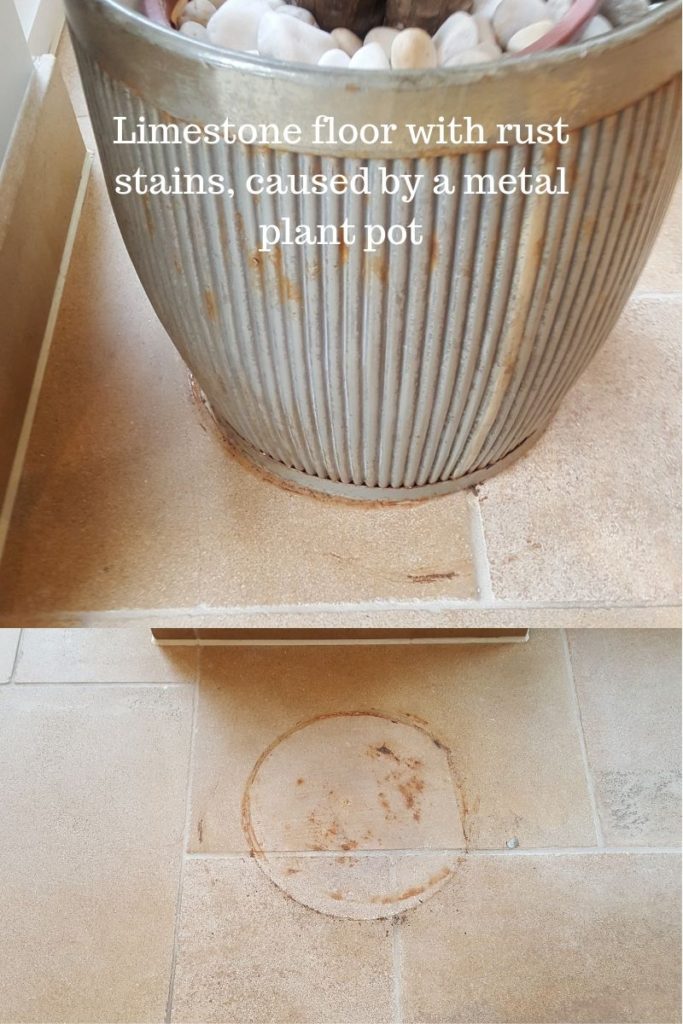
Bathrooms and Toilets (Marble and Limestone)
Toilet cleaners, descalers and bleach will mark marble and limestone almost instantly, never leave bottles containing these liquids to stand on any marble or limestone surface in your bathroom.
MARBLE VANITY TOPS
Any leaks around the taps should be reported or fixed as soon as possible. Limescale does form very quickly in hard water areas. If left for too long the limescale will eat away the marble or limestone surface.
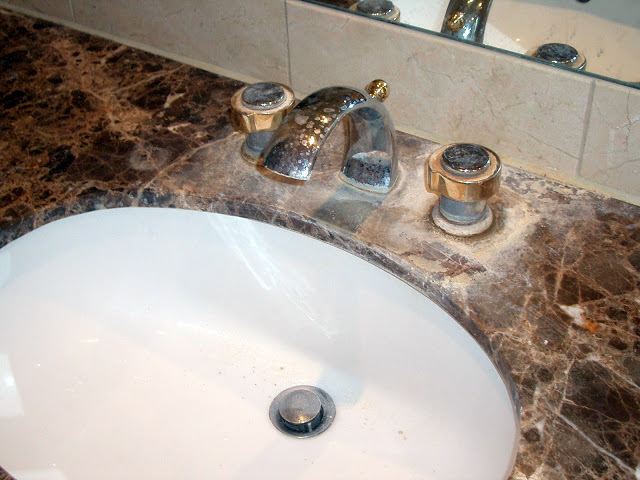
Aftershave, perfume and some hand soaps contain a small amount of alcohol. Spillages from these products will mark or etch the stone even if left for a short period of time.
It is best to keep such items in little containers on your vanity top along with other oil-based cosmetics.
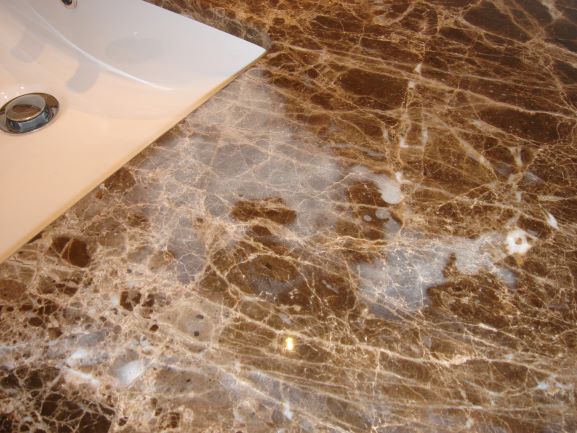
Toothpaste if left to dry on the surface of polished marble or limestone will remove the shine.
The same as for kitchen worktops keep these areas as dry as you can. Blot any spillages, wipe and buff dry immediately after use.
Toilet brush holder – Avoid using a brush holder with a metal base, any moisture between the metal and the stone and it will leave a rust mark.
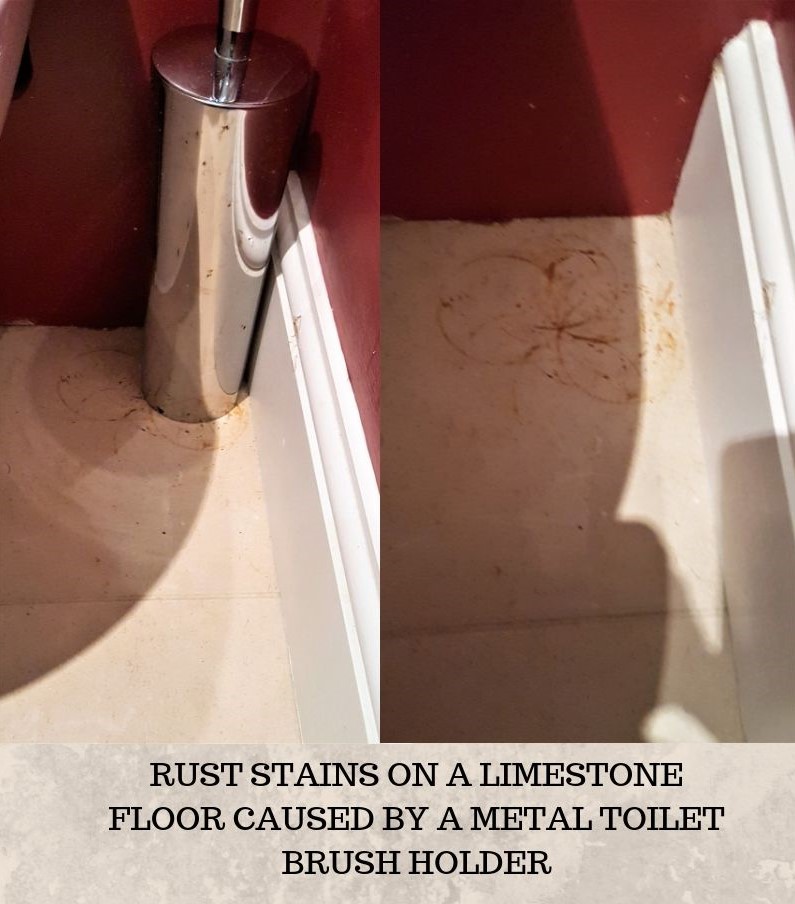
Keep this area dry and check them for leaks. Also, be careful if you have toilet cleaner in the water if it leaks the chemical will mark the floor.
MARBLE SHOWER WALLS
Do not leave soapy water to dry on the walls. It will result in dull streaks, use a squeegee to remove as much excess water as soon as you finish using the area.
Cleaning shower walls – Use a bowl with hot water and a mild cleaning agent or stone soap. Sponge it down and then use the squeegee to remove the excess water or buff it dry with a clean cloth. Do not sponge it down and leave it to dry it will leave streaks.
When cleaning the area never spray undiluted cleaning chemicals onto the marble it will mark the stone.
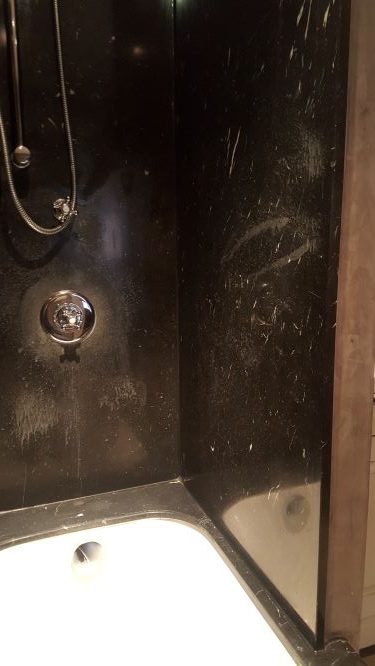
Dining Tables and Coffee Tables
Always use placemats and coasters etc. Especially where alcohol is concerned, spirits and wine will remove a shine on a polished marble table in minutes. If left for a longer period it will etch the stone.
Sugary drinks like cola and lemonade if left to dry on the surface will remove the shine.
Having a dinner party, protect your marble table with a plastic sheet under the table cloth. It could be hours before you can clear up any spillages, by which time the damage is done.
Potted plants and flower arrangements
You should always have a dish, a tray or saucer under potted plants, and check them a few minutes after watering the plant in case the dish overflows with water.
The damage caused to natural stone covered by a potted plant for a long time is one of the most difficult to rectify, water and bits of soil could remain under the plants for weeks or months before you notice the damage. Do not over water the plants and check under them regularly.
Flower arrangements – Remove any dead flower petals etc from the surface of the table as soon as possible, if left too long it can stain some natural stones.
Do not over fill the vase with water and dry any spillage as soon as possible.
When moving pots and vases over the surface of the stone pick it up and place it. Never slide it across the table, it will scratch the stone. Before moving them also check if there is any soil or grit under the pot.
Fireplace (Mantles)
Candle wax will mark
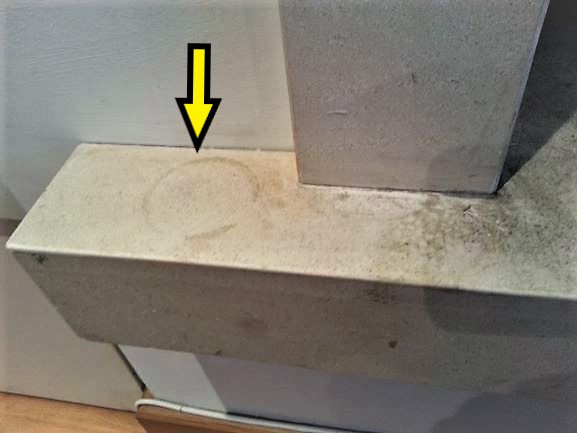
Small potted plants should always have a tray or small dish under them and check under them regularly in case of le
Ornaments or picture frames etc made of metal no matter how small can scratch the stone. When moving them around, always pick them up and place them. You should avoid sliding them across the surface of the stone.
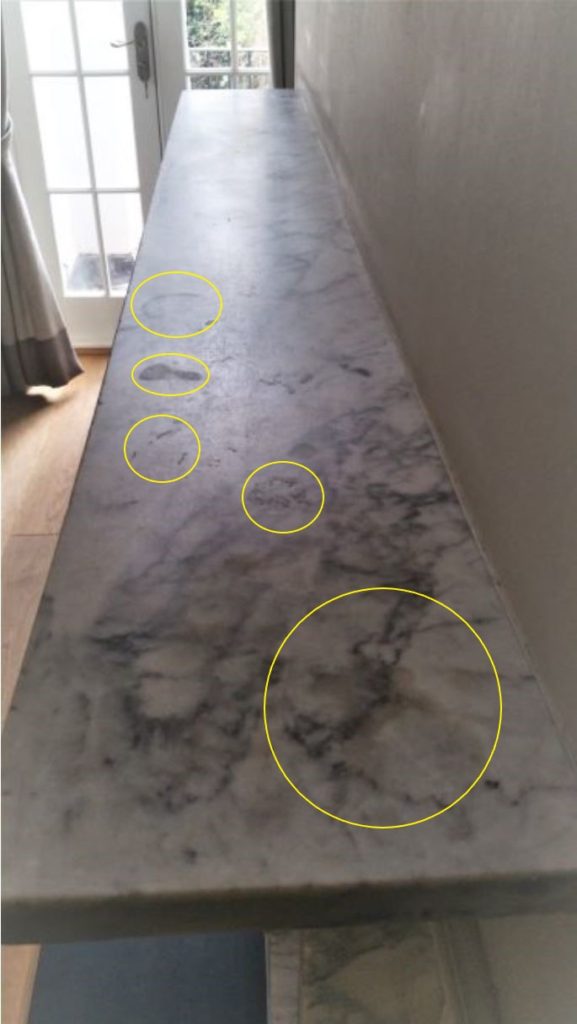
The Marble Fireplace Shelf in this image is supposed to have a polished finish. It has wax stains, etch marks from a bottle or glass containing alcohol. There are some deep scratches and a dull spot where a substance has been left to dry on the marble. Along the front edge of the marble there are numerous chips and an area that looks like an object was repeatedly drop on the marble. All of this damage could have been avoided.
When cleaning with chemicals or a damp cloth. Ensure that you always buff the surface until it is completely dry of your cleaning solution. Any moisture between the stone and the metal will leave a rust stain.
When polishing a mantle use the product sparingly and buff it until it is completely dry and shiny. If the polish looks smeary it is not compl
Fireplace (Hearths)
Never stand on a hearth. At any time, even when cleaning the mantle. Most modern fireplaces with a hearth fitted have a void between the stone and the floor. Anything heavy on it will cause it to crack or break. Hearths that are set into or on the floor can support a little more weight. However, it is still advisable to never stand on them as a replacement can be very expensive.
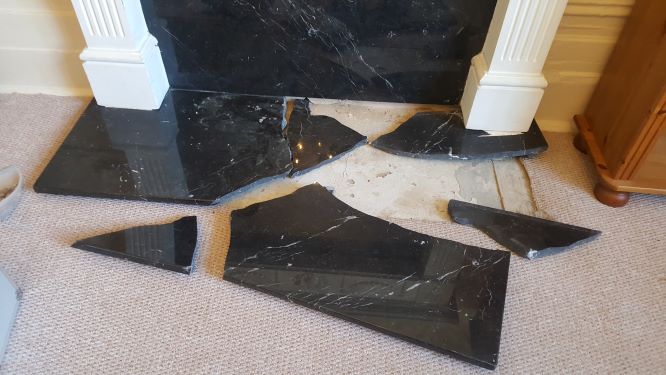
As with the mantle if you have potted plants or candles in this area place a dish or a tray under them to protect against spillages and to stop the wax from seeping into the stone.
Fire tools and fire baskets. These items should always be lifted and placed to one side when cleaning. Never slide or drag them over the stone or it will scratch the hearth.
When sweeping or vacuuming around the hearth special care should be taken to avoid striking the stone. The edges will chip. Some of my most common repairs are to the chipped edges of natural stone hearths.
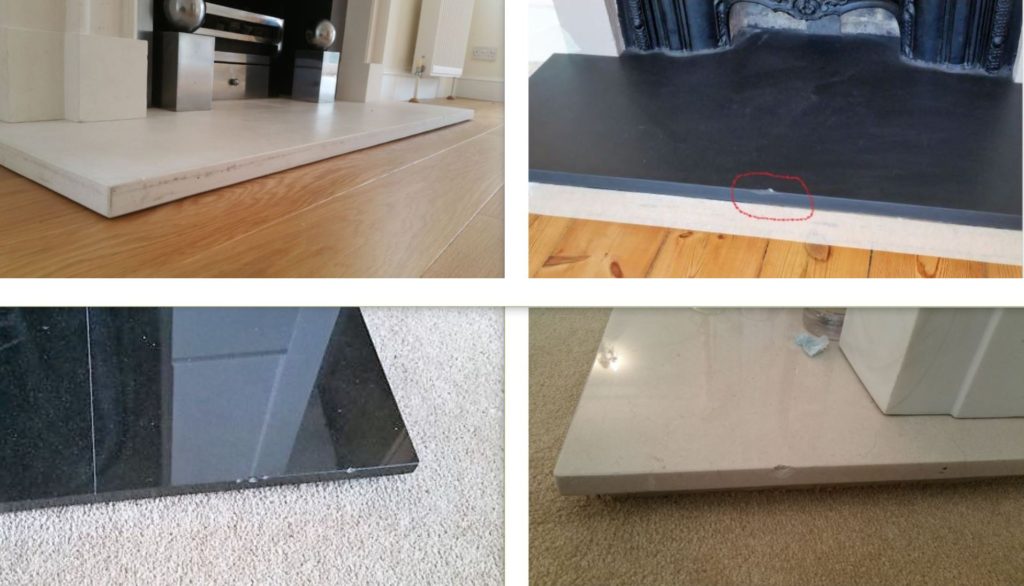
ALL SCUFFED OR CHIPPED BY BROOMS OR VACUUMS
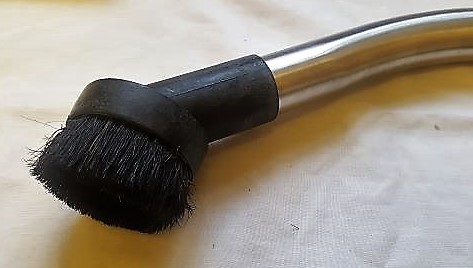
Honed Slate Hearths – Do scratch very quickly, so when cleaning the dust or ash from a slate hearth use the soft brush attachment of your vacuum cleaner. Hover it over the dust or ash to remove it. Sweeping it or dusting it will scratch the stone.
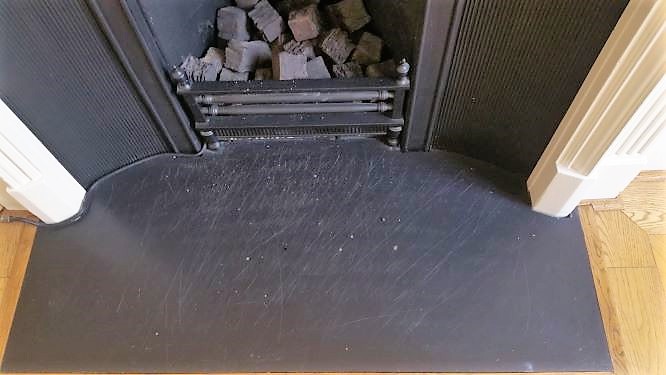
Final Thoughts
Natural stone is hard wearing and will give you many years of service and pleasure, but you should give it the same considerations as other materials. Just a little thought and planning will avoid many problems.
